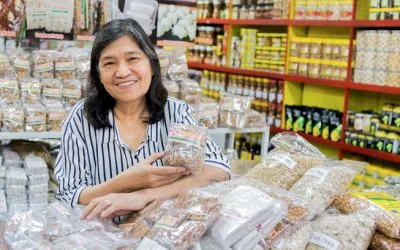Almost every region in the Philippines has its own version of puto or rice cake, but what has come to be known as Puto Biñan is exceptional. The use of pulverized rice makes its texture and taste superior compared to others. It is fluffy yet moist, and is as big as a pizza. It is generously topped with grated cheese, salted egg bits, and drizzles of condensed milk. Unlike the putong puti (white rice cake) that is usually paired with dinuguan (pig blood-based stew), the Puto Biñan demands to stand on its own—it is good as it is.
The longest standing home and world-renowned recipe of Puto Biñan happens to have been innovated in the kitchen of a plain housewife. In the long and crippling history of colonial patriarchy, she was wrongfully put on a pedestal as if she was a fragile ornamental work who should not be allowed to do a man’s job. She may not have been conscious of it, but her inner being longed for the free and powerful precolonial woman that she was. Hence, she creatively looked for ways to reclaim the autonomy and control that was stolen from her, even within the very domestication that caged her.
Although Filipinas were no longer as confined within the domestic realm during the American occupation as opportunities opened up to them, the belief from the nearly four centuries of Spanish rule that Filipinas were the inferior sex was still deeply entrenched in the social consciousness of the Filipinos. Thus, Petronila “Nila” Samaniego was not allowed by her husband to work for the family. She was expected to focus on being a loving wife and a caring mother, that’s all. But her innate curiosity and creativity, plus an unimaginable amount of free time and much experience in the kitchen, prompted her to experiment on puto.
Now almost a century old, Aling Nila’s experimental recipe is still being made in its original home factory now managed by her heir, Marvin Endriga. At the back of the house, puto makers first do the galapong (batter) by combining rice flour, brown sugar, and baking powder with water. The galapong is poured onto the lansungan (steamer), then covered with katsa (muslin cloth). It is then steamed in an oven fired with ipa (rice husk). The toppings are put on top of the puto a few minutes before it is completely cooked so that their flavors will be incorporated into the puto.
Originally, the puto was sold only by the box. It was peddled at the old Biñan Station of the South Main Line of the Philippine National Railways in Barangay Santo Niño. The vendors would hop into the coaches to offer their product either as a merienda to eat during the trip or as a pasalubong (bringhome gift) for the family. This was a normal sight to the passengers who would comment, “Nariyan na naman ang mga magpuputo ng Biñan” (Here come the puto vendors of Biñan again). Perhaps this is how the puto eventually became known as Puto Biñan.
Later on, Marvin’s mother, Florencia Samaniego Endriga, thought of catering also to customers who wanted to buy puto in small slices. Now, individually wrapped pocket-sized Aling Nila’s puto can be seen peddled on the streets, in public markets, and on sidewalks. This strategy also paved the way for small-scale resellers – those who do not have a large enough capital to start their own business and who, like Aling Nila then, are just ordinary people, each with their simple life stories. The retailing of Puto Biñan has made this delicacy a staple not only for big gatherings like fiestas, Mahal na Araw, Undras, Noche Buena, and Media Noche, but to any Biñanense who simply wants to munch on it after a long day of hard work. It is now part of any Biñanense’s everyday life and special holidays alike.
The Puto Biñan was also the main inspiration behind the city’s now yearly Puto Latik Festival – a fiesta to lionize the city’s very own Puto Biñan and folk dance, “maglalatik”. Who would have thought that one lifeless afternoon’s experiment of a plain housewife stuck in domestic work would inspire an annual festival that brings high spirits to this burgeoning city? It was the woman who was not allowed to work who has created more jobs in the past hundred years. It was the faceless woman who created an identity for Biñan as the city embraces her creation as its own.



